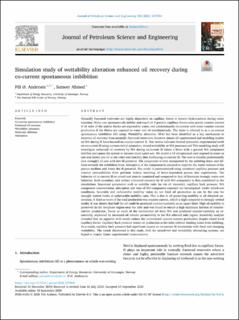| dc.contributor.author | Andersen, Pål Østebø | |
| dc.contributor.author | Ahmed, Sameer | |
| dc.date.accessioned | 2021-02-15T12:53:28Z | |
| dc.date.available | 2021-02-15T12:53:28Z | |
| dc.date.created | 2020-09-16T22:02:26Z | |
| dc.date.issued | 2020-09 | |
| dc.identifier.citation | Andersen, P.Ø., Ahmed, S. (2020) Simulation study of wettability alteration enhanced oil recovery during co-current spontaneous imbibition. Journal of Petroleum Science and Engineering, 196, 107954 | en_US |
| dc.identifier.issn | 0920-4105 | |
| dc.identifier.uri | https://hdl.handle.net/11250/2728113 | |
| dc.description.abstract | Naturally fractured reservoirs are highly dependent on capillary forces to recover hydrocarbons during water injection. Water can spontaneously imbibe and expel oil if positive capillary forces exist; purely counter-current if all sides of the matrix blocks are exposed to water; and predominantly co-current with some counter-current production if the blocks are exposed to water and oil simultaneously. The latter is referred to as a co-current spontaneous imbibition (SI) setup. Wettability alteration (WA) has been identified as a key mechanism to improve oil recovery from naturally fractured reservoirs, however almost all experimental and modeling studies on WA during SI have focused on counter-current SI. Our review indicates limited systematic experimental work on co-current SI using nonzero initial saturation, mixed wettability or WA processes and This modeling study will investigate enhanced oil recovery by WA during co-current SI where a brine with a general WA component imbibes and causes the system to become more water-wet. We model a 1D oil-saturated core exposed to water at one end (inlet) and oil at the other end (outlet), thus facilitating co-current SI. The core is initially preferentially (not strongly) oil-wet with low SI potential. The component is both transported by the imbibing brine and diffuses towards the imbibition front. Adsorption of the component is assumed to improve the water-wetness of the porous medium and hence the SI potential. The model is parameterized using consistent capillary pressure and relative permeabilities from previous history matching of brine-dependent porous disc experiments. The behavior of co-current SI at mixed-wet state is examined and compared to that of literature strongly water-wet behavior. Both secondary and tertiary enhanced recovery by SI with WA component is then considered in the simulations. Important parameters such as mobility ratio (as via oil viscosity), capillary back pressure, WA component concentration, adsorption and time of WA component exposure are investigated. Under mixed-wet conditions, favorable and unfavorable mobility ratios do not limit oil production as can be the case for strongly wetted media at unfavorable mobility ratio. This is due to oil preserving mobility at all obtained saturations. A third or more of the total production was counter-current, which is high compared to strongly wetted media. It was shown that half the oil could be produced counter-currently as an upper limit. High oil mobility is preserved in the twophase region near the inlet and was found to ensure a high minimum fraction of counter-current production. Twice as much of the incremental oil from WA was produced counter-currently as co-currently, explained by increased oil relative permeability in the WA affected inlet region. Sensitivity analysis revealed that an opposite shift would reduce the incremental counter-current production despite raised local capillary forces. Capillary back pressure resists oil production at the inlet without limiting water from imbibing. As a result, capillary back pressure had significant impact on co-current SI simulations with fixed and changing wettability. The trends discovered in this study, both for mixed-wet and wettability alternating systems, are hoped to inspire future experimental measurements. | en_US |
| dc.language.iso | eng | en_US |
| dc.publisher | Elsevier Ltd. | en_US |
| dc.rights | Navngivelse 4.0 Internasjonal | * |
| dc.rights.uri | http://creativecommons.org/licenses/by/4.0/deed.no | * |
| dc.title | Simulation study of wettability alteration enhanced oil recovery during co-current spontaneous imbibition | en_US |
| dc.type | Peer reviewed | en_US |
| dc.type | Journal article | en_US |
| dc.description.version | publishedVersion | en_US |
| dc.rights.holder | © 2020 The Authors. | en_US |
| dc.subject.nsi | VDP::Teknologi: 500::Berg‑ og petroleumsfag: 510::Petroleumsteknologi: 512 | en_US |
| dc.source.volume | 196 | en_US |
| dc.source.journal | Journal of Petroleum Science and Engineering | en_US |
| dc.identifier.doi | 10.1016/j.petrol.2020.107954 | |
| dc.identifier.cristin | 1830641 | |
| dc.relation.project | Norges forskningsråd: 230303 | en_US |
| dc.source.articlenumber | 107954 | en_US |
| cristin.ispublished | true | |
| cristin.fulltext | postprint | |
| cristin.fulltext | original | |
| cristin.qualitycode | 2 | |

